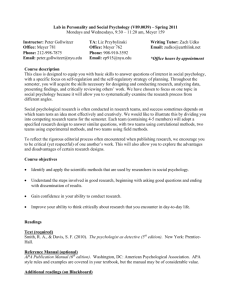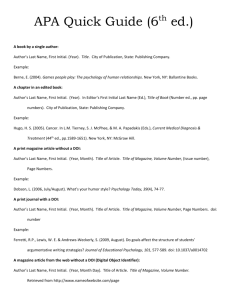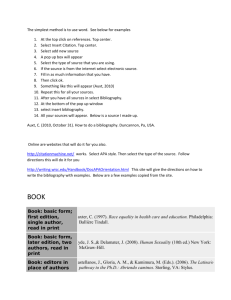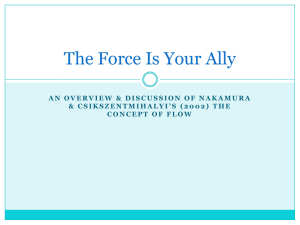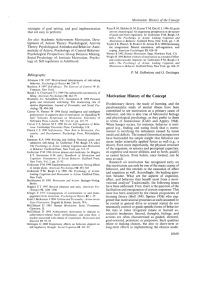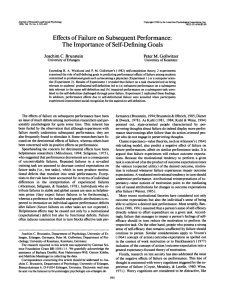Supplementary Material
advertisement
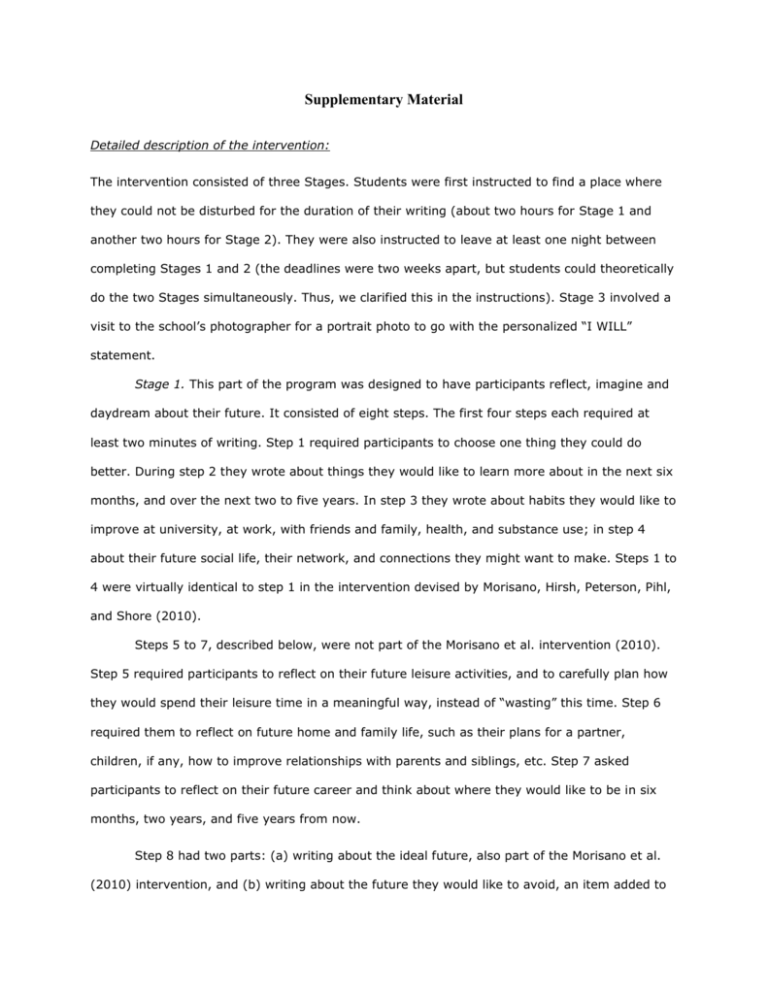
Supplementary Material Detailed description of the intervention: The intervention consisted of three Stages. Students were first instructed to find a place where they could not be disturbed for the duration of their writing (about two hours for Stage 1 and another two hours for Stage 2). They were also instructed to leave at least one night between completing Stages 1 and 2 (the deadlines were two weeks apart, but students could theoretically do the two Stages simultaneously. Thus, we clarified this in the instructions). Stage 3 involved a visit to the school’s photographer for a portrait photo to go with the personalized “I WILL” statement. Stage 1. This part of the program was designed to have participants reflect, imagine and daydream about their future. It consisted of eight steps. The first four steps each required at least two minutes of writing. Step 1 required participants to choose one thing they could do better. During step 2 they wrote about things they would like to learn more about in the next six months, and over the next two to five years. In step 3 they wrote about habits they would like to improve at university, at work, with friends and family, health, and substance use; in step 4 about their future social life, their network, and connections they might want to make. Steps 1 to 4 were virtually identical to step 1 in the intervention devised by Morisano, Hirsh, Peterson, Pihl, and Shore (2010). Steps 5 to 7, described below, were not part of the Morisano et al. intervention (2010). Step 5 required participants to reflect on their future leisure activities, and to carefully plan how they would spend their leisure time in a meaningful way, instead of “wasting” this time. Step 6 required them to reflect on future home and family life, such as their plans for a partner, children, if any, how to improve relationships with parents and siblings, etc. Step 7 asked participants to reflect on their future career and think about where they would like to be in six months, two years, and five years from now. Step 8 had two parts: (a) writing about the ideal future, also part of the Morisano et al. (2010) intervention, and (b) writing about the future they would like to avoid, an item added to this intervention. In writing about their ideal future, participants had to integrate all the things they had written about in previous parts. They had to think about who and what they wanted to be; where they wanted to end up; why, how, and when they would put their plans into action. This part took at least 15 minutes of non-stop writing. Participants were reminded that these were their own private goals but should be related to a life they would regard as honorable, exciting, productive, creative and decent. In the 15 minutes they spent describing the future they would prefer to avoid, participants had to reflect on what their life would be like if they failed to define or pursue goals, if bad habits spiraled out of control, and if they ended up miserable, resentful and bitter. The idea behind this part was to let participants visualize both a desirable and an undesirable future, and to get them to contrast the two, as a form of “metacognitive self-regulatory strategy of goal pursuit” (Duckworth, Kirby, Gollwitzer, & Oettingen, 2013; p. 745; cf. Schippers, Homan, & van Knippenberg, 2013). This form of mental contrasting with implementation intentions was designed to make them to outline a strategy for how they could achieve their desired goals and at the same time to think about what could happen if they failed to achieve those goals. These steps represented a goal-framing effect: research has shown that people are more likely to take action when they are confronted with the possible consequences of not doing so (Tversky & Kahneman, 1981). Stage 2. This part of the program consisted of four steps. It was designed to help participants strategize and prioritize their goals, plan for set-backs, and monitor progress towards goals. It was virtually identical to the goal-setting intervention used by Morisano et al. (2010). The first step required participants to provide a brief description of the ideal future as a whole. Step 2 asked students to spend 10-15 minutes specifying and clarifying their goals. They were asked to break down their ideal future into 6 to 8 titled goals – personal, career and social. In step 3, they were asked to rank their now-titled goals in order of priority. Step 4 asked students to evaluate their motivations for their goals, consider the broad personal and social impact of those goals, write a detailed strategy for goal attainment, identify potential obstacles and solutions, and monitor progress towards desired goals. Students were asked to be specific and concrete here – for instance, to write down weekly or daily things that they would do to further their goal. Detailed implementation plans have been shown to aid goal progress (Gollwitzer, 1996). Stage 3. The online goal-setting program was coupled with an initiative called “I WILL”, developed by the business school, for both students and staff. This involves participants each devising a one-sentence statement that captures their goals and ambitions, accompanied by a professional personal photo. The idea behind this initiative was that students and staff would share their ambitions with the world, and would also, therefore, try harder to realize those ambitions. The link with goal setting was made by asking students to base their statement on the goal-setting exercise. The “I WILL” statement can be seen as a form of public commitment (Hollenbeck, Williams, & Klein, 1989; Schienker, Dlugolecki, & Doherty, 1994), added to enhance goal commitment, an important component of goal success (Oettingen, Pak, & Schnetter, 2001). Students were required to choose a single, important goal and formulate a statement articulating it. They then visited the photographer. The goal statement and consequent photo were combined into a single poster. Examples include: “I will grab opportunities and realize my dream”, “I will give people reasons to rebuild their trust in banking”, “I will manage my time more efficiently” and “I will be the hybrid of Eastern heritage and Western expertise”. References Duckworth, A. L., Kirby, T. A., Gollwitzer, A., & Oettingen, G. (2013). From fantasy to action: Mental contrasting with implementation intentions (MCII) improves academic performance in children. Social Psychological and Personality Science. doi: 10.1177/1948550613476307 Gollwitzer, G. M. (1996). The volitional benefits of planning. In P. M. Gollwitzer & J. A. Bargh (Eds.), The psychology of action: Linking cognition and motivation to behavior. (pp. 287-312). New York: The Guilford Press. Hollenbeck, J. R., Williams, C. R., & Klein, H. J. (1989). An empirical examination of the antecedents of commitment to difficult goals. Journal of Applied Psychology, 74(1), 18-23. doi: 10.1037/0021-9010.74.1.18 Morisano, D., Hirsh, J. B., Peterson, J. B., Pihl, R. O., & Shore, B. M. (2010). Setting, elaborating, and reflecting on personal goals improves academic performance. Journal of Applied Psychology, 95(2), 255-264. Oettingen, G., Pak, H.-j., & Schnetter, K. (2001). Self-regulation of goal-setting: Turning free fantasies about the future into binding goals. Journal of Personality and Social Psychology, 80(5), 736-753. doi: 10.1037/0022-3514.80.5.736 Schienker, B. R., Dlugolecki, D. W., & Doherty, K. (1994). The Impact of self-presentations on selfappraisals and behavior: The power of public commitment. Personality and Social Psychology Bulletin, 20(1), 20-33. doi: 10.1177/0146167294201002 Schippers, Homan, A. C., & van Knippenberg, D. (2013). To reflect or not to reflect: Prior team performance as a boundary condition of the effects of reflexivity on learning and final team performance. Journal of Organizational Behavior, 34(1), 6-23. doi: DOI: 10.1002/job.1784 Tversky, A., & Kahneman, D. (1981). The framing of decisions and the rationality of choice. Science, 211, 453-458.
